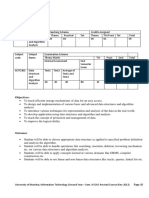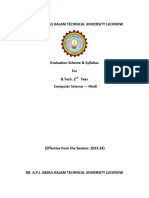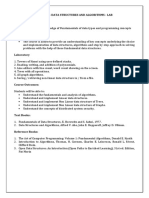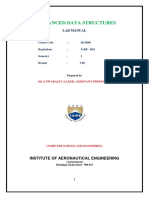Program Distribution List
Uploaded by
pagalbaba.ji2000Program Distribution List
Uploaded by
pagalbaba.ji2000Shambhunath Institute of Engineering & Technology
Department of Computer Science & Engineering
Lecture Plan
Name of Course B. Tech
AKTU Course Code BCS 351
Branch CS
Semester 2nd
Section ALL(CS1,CS2,CS3)
Total Number of Students 195
Name of Faculty VAIBHAV TRIPATHI
Number of Lab Proposed 22
No. of
S.No Topic Labs/Date
Implementing Sorting Techniques:
A. bubble Sort,
B. Insertion Sort,
1 C. Selection Sort, 1st Lab/
D. Shell ,
E. Sort,
F. Radix Sort,
G. Quick sort
Implementing Searching and Hashing Techniques: Linear
search, Binary search, Methods for Hashing:
2 Modulo Division, Digit Extraction, Fold shift, Fold Boundary, LAB3
Linear Probe for Collision Resolution.
Direct and Subtraction hashing
Implementing Stacks: Array implementation, Linked List
3 implementation, Evaluation of postfix LAB3
expression and balancing of parenthesis , Conversion of infix
notation to postfix notation
Implementing Queue: Linked List implementation of ordinary
4 queue, Array implementation of circular LAB2
queue, Linked List implementation of priority queue, Double
ended queue
Implementing Linked List: Singly Linked Lists, Circular Linked
List, Doubly Linked Lists : Insert, Display,
5 a) Delete, Search, Count, Reverse(SLL), Polynomial , Addition ,
Comparative study of arrays and linked list LAB4
b)
Implementing Trees: Binary search tree : Create, Recursive
traversal: preorder, post order, in order,
6 Search Largest , Node, Smallest Node, Count number of nodes,
Heap: Min Heap, Max Heap: reheap Up,
reheap Down, Delete , Expression Tree, Heapsort LAB4
7 Implementing Graphs: Represent a graph using the Adjacency LAB3
Matrix, BFS, Find the minimum
spanning tree (using any method Kruskal’s Algorithm or Prim’s
Algorithm) Self Learning Topics :
Shortest Path Algorithm
Shambhunath Institute of Engineering & Technology
Department of Computer Science & Engineering
Lecture Plan
Name of Course B. Tech
AKTU Course Code BCS 353
Branch CS
Semester 2nd
Section ALL(CS1,CS2,CS3)
Total Number of Students 195
Name of Faculty VAIBHAV TRIPATHI
Number of Lab Proposed 24
No. of
S.No Topic
Labs
1 LAB6
2 4
3 2
4 3
5 2
6 3
7 2
8 3
9 2
10 3
Shambhunath Institute of Engineering & Technology
Department of Computer Science & Engineering
Lecture Plan
Name of Course B. Tech
AKTU Course Code BCS 451
Branch CS
Semester 2nd
Section ALL(CS1,CS2,CS3)
Total Number of Students 195
Name of Faculty VAIBHAV TRIPATHI
Number of Lab Proposed 23
No. of
S.No Topic
Labs
Study of hardware and software requirements of different
1 operating systems (UNIX,LINUX,WINDOWS XP, LAB3
WINDOWS7/8
Execute various UNIX system calls for
i. Process management
2 LAB2
ii. File management
iii. Input/output Systems calls
Implement CPU Scheduling Policies:
i. SJF
3 ii. Priority LAB2
iii. FCFS
iv. Multi-level Queue
Implement file storage allocation technique:
i. Contiguous(using array)
4 LAB2
ii. Linked –list(using linked-list)
iii. Indirect allocation (indexing)
Implementation of contiguous allocation techniques:
i. Worst-Fit
5
ii. Best- Fit
iii. First- Fit
LAB2
Calculation of external and internal fragmentation
i. Free space list of blocks from system 6
ii. List process file from the system LAB2
Implementation of compaction for the continually changing
6 memory layout and calculate total movement
of data
LAB1
7 Implementation of resource allocation graph RAG)
8 Implementation of Banker‟s algorithm LAB1
Conversion of resource allocation graph (RAG) to wait for
9 graph (WFG) for each type of method used for LAB2
storing graph.
Implement the solution for Bounded Buffer (producer-
10 consumer)problem using inter process LAB3
communication techniques-Semaphores
Implement the solutions for Readers-Writers problem using
11 inter process communication technique - LAB3
Semaphore
Shambhunath Institute of Engineering & Technology
Department of Computer Science & Engineering
Lecture Plan
Name of Course B. Tech
AKTU Course Code BCS 452
Branch CS
Semester 2nd
Section ALL(CS1,CS2,CS3)
Total Number of Students 195
Name of Faculty VAIBHAV TRIPATHI
Number of Lab Proposed 20
No. of
S.No Topic
Labs
Use Java compiler and eclipse platform to write and execute
1 LAB2
java program.
2 Creating simple java programs using command line arguments LAB1
3 Understand OOP concepts and basics of Java programming. LAB3
4 Create Java programs using inheritance and polymorphism. LAB2
Implement error-handling techniques using exception handling
5 LAB2
and multithreading.
6 Create java program with the use of java packages. LAB2
7 Construct java program using Java I/O package. LAB2
Create industry oriented application using Spring Framework.
8 LAB2
9 Test RESTful web services using Spring Boot. LAB3
10 Test Frontend web application with Spring Boo t LAB3
Shambhunath Institute of Engineering & Technology
Department of Computer Science & Engineering
Lecture Plan
Name of Course B. Tech
AKTU Course Code BCS 453
Branch CS
Semester 2nd
Section ALL(CS1,CS2,CS3)
Total Number of Students 195
Name of Faculty VAIBHAV TRIPATHI
Number of Lab Proposed 22
Module 1: Packet Analysis using Wire shark
No. of
S.No Topic
Labs
Basic Packet Inspection: Capture network traffic using Wire
shark and analyze basic protocols like
1 HTTP, DNS, and SMTP to understand how data is transmitted LAB3
and received.
Detecting Suspicious Activity: Analyze network traffic to
identify suspicious patterns, such as repeated
2 connection attempts or unusual communication between LAB2
hosts.
Malware Traffic Analysis: Analyze captured traffic to identify
3 signs of malware communication, such as LAB2
command-and-control traffic or data infiltration.
Password Sniffing: Simulate a scenario where a password is
transmitted in plaintext. Use Wireshark to
4 capture and analyze the packets to demonstrate the LAB2
vulnerability and the importance of encryption.
ARP Poisoning Attack: Set up an ARP poisoning attack using
tools like Ettercap. Analyze the captured
5 packets to understand how the attack can lead to a Man-in- LAB2
the-Middle scenario.
Module 2: Web Application Security using DVWA
No. of
S.No Topic
Labs
SQL Injection: Use DVWA to practice SQL injection attacks.
Demonstrate how an attacker can
1 manipulate input fields to extract, modify, or delete database LAB3
information.
Cross-Site Scripting (XSS): Exploit XSS vulnerabilities in DVWA
to inject malicious scripts into web pages.
2 Show the potential impact of XSS attacks, such as stealing LAB2
cookies or defacing websites.
Cross-Site Request Forgery (CSRF): Set up a CSRF attack in
DVWA to demonstrate how attackers can
3 manipulate authenticated users into performing unintended LAB2
actions.
File Inclusion Vulnerabilities: Explore remote and local file
inclusion vulnerabilities in DVWA. Show how
4 attackers can include malicious files on a server and execute LAB2
arbitrary code.
Brute-Force and Dictionary Attacks: Use DVWA to simulate
login pages and demonstrate brute-force
5 and dictionary attacks against weak passwords. Emphasize LAB2
the importance of strong password policies.
You might also like
- Btech Cse Curriculum N Syllabus 2015 RMPNo ratings yetBtech Cse Curriculum N Syllabus 2015 RMP99 pages
- Final Consolidated Sem IV Scheme and Syllabus 25-11No ratings yetFinal Consolidated Sem IV Scheme and Syllabus 25-1153 pages
- DSAL orientation for practical examinationNo ratings yetDSAL orientation for practical examination3 pages
- Course Structure & Syllabus of Bachelor of Technology (B.Tech)No ratings yetCourse Structure & Syllabus of Bachelor of Technology (B.Tech)3 pages
- MRSPTU B.tech. CSE (Sem 3-8) Syllabus 2016 Batch Onwards Updated On 29.7.2017No ratings yetMRSPTU B.tech. CSE (Sem 3-8) Syllabus 2016 Batch Onwards Updated On 29.7.201749 pages
- S.R.M. University Faculty of Enginering and Technology: Programme: B.Tech (Cse) - Part TimeNo ratings yetS.R.M. University Faculty of Enginering and Technology: Programme: B.Tech (Cse) - Part Time76 pages
- Kadi Sarva Vishwavidyalaya: Faculty of Engineering & TechnologyNo ratings yetKadi Sarva Vishwavidyalaya: Faculty of Engineering & Technology4 pages
- Computer Science & Engineering 2015 AdmissionNo ratings yetComputer Science & Engineering 2015 Admission16 pages
- Pondicherry University Mca Syllabus MCA-CBCS-2009No ratings yetPondicherry University Mca Syllabus MCA-CBCS-200960 pages
- Department of Computer Science & Engineering: Time TableNo ratings yetDepartment of Computer Science & Engineering: Time Table14 pages
- B - Tech - Computer Science Design - Upto 4th Sem - Batch 2023 OnwardsNo ratings yetB - Tech - Computer Science Design - Upto 4th Sem - Batch 2023 Onwards31 pages
- (ME Computer Science and Engineering) : Structure of Post GraduateNo ratings yet(ME Computer Science and Engineering) : Structure of Post Graduate43 pages
- SWE2001 - DATA-STRUCTURES-AND - ITS-APPLICATIONS - ETH - 1.3 - 15 - SWE2001 - Data Structures and Its Applications - 1.3No ratings yetSWE2001 - DATA-STRUCTURES-AND - ITS-APPLICATIONS - ETH - 1.3 - 15 - SWE2001 - Data Structures and Its Applications - 1.34 pages
- CSE Teaching Scheme Syllabus Sem-III to VIIINo ratings yetCSE Teaching Scheme Syllabus Sem-III to VIII50 pages
- CB19241-CSBS-Data Structures and Algorithms-Lab SyllabusNo ratings yetCB19241-CSBS-Data Structures and Algorithms-Lab Syllabus3 pages
- R22B.tech.CSECourseStructureSyllabus2..No ratings yetR22B.tech.CSECourseStructureSyllabus2..89 pages
- Fundamentals of Distributed Object Systems: The CORBA PerspectiveFrom EverandFundamentals of Distributed Object Systems: The CORBA PerspectiveNo ratings yet
- SUGAMA PORTAL - HELP DOCUMENT FOR OFFICIALS - VER 2.0 2023 jul 29No ratings yetSUGAMA PORTAL - HELP DOCUMENT FOR OFFICIALS - VER 2.0 2023 jul 2917 pages
- User Guide - Guía Del Usuario: 15.6" LCD TV 720P - Televisor LCD de 15.6" Con 720pNo ratings yetUser Guide - Guía Del Usuario: 15.6" LCD TV 720P - Televisor LCD de 15.6" Con 720p0 pages
- Software Requirements Specification: Version 1.0 ApprovedNo ratings yetSoftware Requirements Specification: Version 1.0 Approved6 pages
- User Manuals: FFSJ-Lite vs. FFSJ-StandardNo ratings yetUser Manuals: FFSJ-Lite vs. FFSJ-Standard12 pages
- Jspeciesws: A Web Server For Prokaryotic Species Circumscription Based On Pairwise Genome ComparisonNo ratings yetJspeciesws: A Web Server For Prokaryotic Species Circumscription Based On Pairwise Genome Comparison3 pages
- Controllers: For Industrial Power SystemsNo ratings yetControllers: For Industrial Power Systems40 pages
- Weighted Boxes Fusion: Ensembling Boxes From Different Object Detection ModelsNo ratings yetWeighted Boxes Fusion: Ensembling Boxes From Different Object Detection Models9 pages
- Augmented Reality E-Commerce: How The Technology Benefits People's LivesNo ratings yetAugmented Reality E-Commerce: How The Technology Benefits People's Lives24 pages
- Junior Cert Science Coursework B 2015 Chemistry100% (1)Junior Cert Science Coursework B 2015 Chemistry8 pages
- Relevancy of Electronic Records and Its Admissibility in Criminal ProceedingsNo ratings yetRelevancy of Electronic Records and Its Admissibility in Criminal Proceedings14 pages
- B CH Config Xe 16 11 1 ncs4200 - Chapter - 01011No ratings yetB CH Config Xe 16 11 1 ncs4200 - Chapter - 0101134 pages
- Estimating Multilevel Models Using SPSS, Stata, SAS and RNo ratings yetEstimating Multilevel Models Using SPSS, Stata, SAS and R35 pages
- Final Consolidated Sem IV Scheme and Syllabus 25-11Final Consolidated Sem IV Scheme and Syllabus 25-11
- Course Structure & Syllabus of Bachelor of Technology (B.Tech)Course Structure & Syllabus of Bachelor of Technology (B.Tech)
- MRSPTU B.tech. CSE (Sem 3-8) Syllabus 2016 Batch Onwards Updated On 29.7.2017MRSPTU B.tech. CSE (Sem 3-8) Syllabus 2016 Batch Onwards Updated On 29.7.2017
- S.R.M. University Faculty of Enginering and Technology: Programme: B.Tech (Cse) - Part TimeS.R.M. University Faculty of Enginering and Technology: Programme: B.Tech (Cse) - Part Time
- Kadi Sarva Vishwavidyalaya: Faculty of Engineering & TechnologyKadi Sarva Vishwavidyalaya: Faculty of Engineering & Technology
- Department of Computer Science & Engineering: Time TableDepartment of Computer Science & Engineering: Time Table
- B - Tech - Computer Science Design - Upto 4th Sem - Batch 2023 OnwardsB - Tech - Computer Science Design - Upto 4th Sem - Batch 2023 Onwards
- (ME Computer Science and Engineering) : Structure of Post Graduate(ME Computer Science and Engineering) : Structure of Post Graduate
- SWE2001 - DATA-STRUCTURES-AND - ITS-APPLICATIONS - ETH - 1.3 - 15 - SWE2001 - Data Structures and Its Applications - 1.3SWE2001 - DATA-STRUCTURES-AND - ITS-APPLICATIONS - ETH - 1.3 - 15 - SWE2001 - Data Structures and Its Applications - 1.3
- CB19241-CSBS-Data Structures and Algorithms-Lab SyllabusCB19241-CSBS-Data Structures and Algorithms-Lab Syllabus
- Fundamentals of Distributed Object Systems: The CORBA PerspectiveFrom EverandFundamentals of Distributed Object Systems: The CORBA Perspective
- Oracle Certified Professional Java Programmer OCPJP 1Z0 809From EverandOracle Certified Professional Java Programmer OCPJP 1Z0 809
- SUGAMA PORTAL - HELP DOCUMENT FOR OFFICIALS - VER 2.0 2023 jul 29SUGAMA PORTAL - HELP DOCUMENT FOR OFFICIALS - VER 2.0 2023 jul 29
- User Guide - Guía Del Usuario: 15.6" LCD TV 720P - Televisor LCD de 15.6" Con 720pUser Guide - Guía Del Usuario: 15.6" LCD TV 720P - Televisor LCD de 15.6" Con 720p
- Software Requirements Specification: Version 1.0 ApprovedSoftware Requirements Specification: Version 1.0 Approved
- Jspeciesws: A Web Server For Prokaryotic Species Circumscription Based On Pairwise Genome ComparisonJspeciesws: A Web Server For Prokaryotic Species Circumscription Based On Pairwise Genome Comparison
- Weighted Boxes Fusion: Ensembling Boxes From Different Object Detection ModelsWeighted Boxes Fusion: Ensembling Boxes From Different Object Detection Models
- Augmented Reality E-Commerce: How The Technology Benefits People's LivesAugmented Reality E-Commerce: How The Technology Benefits People's Lives
- Relevancy of Electronic Records and Its Admissibility in Criminal ProceedingsRelevancy of Electronic Records and Its Admissibility in Criminal Proceedings
- Estimating Multilevel Models Using SPSS, Stata, SAS and REstimating Multilevel Models Using SPSS, Stata, SAS and R

























































































